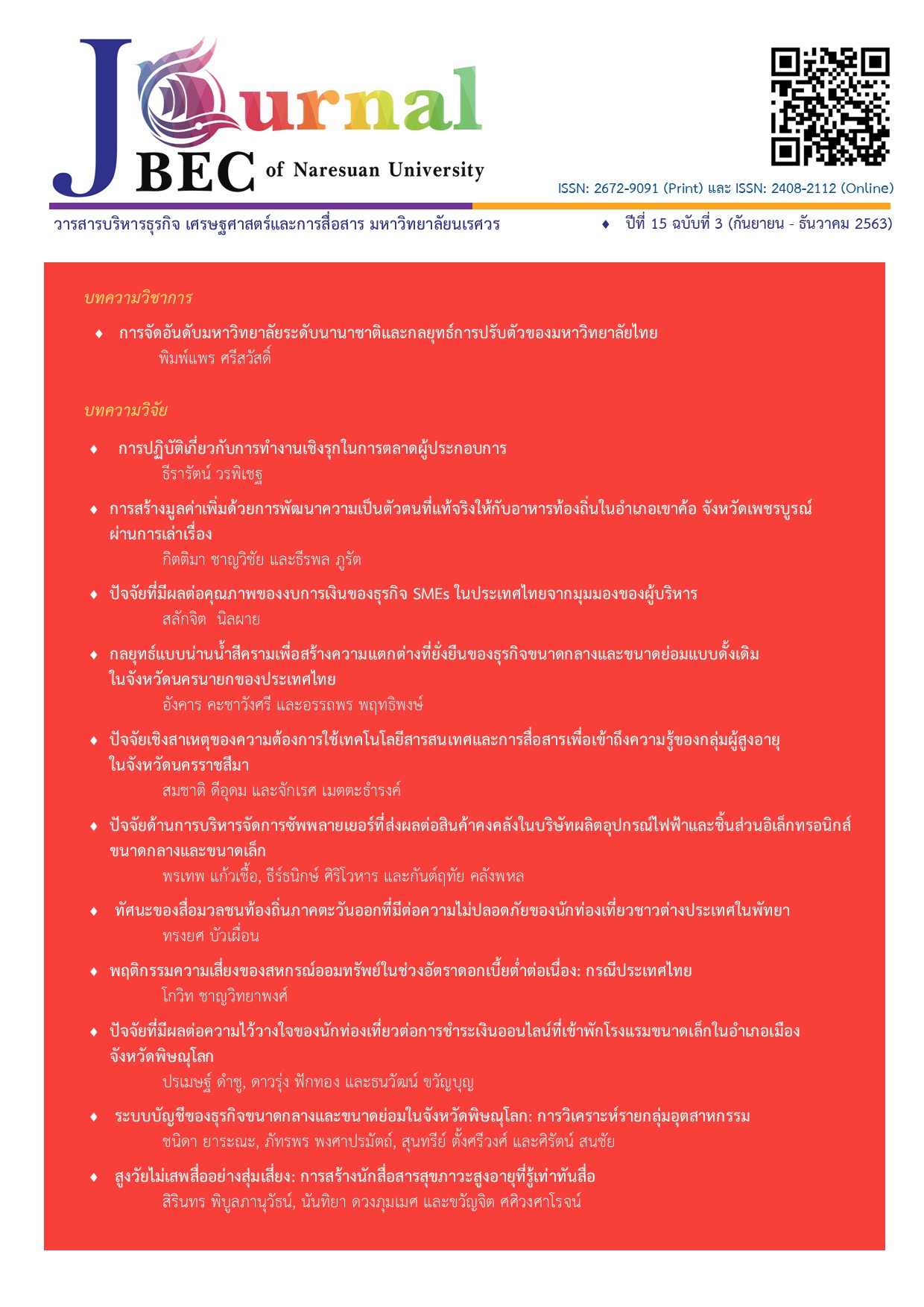สูงวัยไม่เสพสื่ออย่างสุ่มเสี่ยง: การสร้างนักสื่อสารสุขภาวะสูงอายุที่รู้เท่าทันสื่อ
Main Article Content
บทคัดย่อ
งานวิจัยนี้มีวัตถุประสงค์เพื่อ 1) เสริมสร้างทักษะการรู้เท่าทันสื่อและสารสนเทศแก่ผู้สูงอายุ 2) เสริมพลังให้ผู้สูงอายุตระหนักในคุณค่าของตนผ่านการเป็นนักสื่อสารสุขภาวะที่สามารถสร้างสรรค์สื่อได้อย่างเหมาะสมกับบริบทของชุมชนและสถานการณ์ของสังคม และร่วมสร้างการเปลี่ยนแปลงให้ชุมชนหรือสังคม 3) ได้องค์ความรู้เกี่ยวกับการสร้างพลเมืองสูงวัยเป็นนักสื่อสารสุขภาวะในสังคมไทย ใช้วิธีวิจัยเชิงปฏิบัติการแบบมีส่วนร่วมกับกลุ่มนักเรียนสูงอายุใน 5 พื้นที่ทั่วประเทศ คือภาคเหนือ ภาคตะวันออกเฉียงเหนือ ภาคกลาง ภาคใต้ และกรุงเทพมหานคร จำนวนทั้งสิ้น 268 คน ผลการวิจัยพบว่าผู้สูงอายุที่เข้าร่วมโครงการมีความรู้เท่าทันสื่อเพิ่มขึ้น การใช้คาถารู้ทันสื่อ “หยุด-คิด-ถาม-ทำ” ช่วยลดพฤติกรรมเสี่ยงที่เกิดจากการเสพสื่ออย่างไม่รู้เท่าทันในกลุ่มผู้สูงอายุ การรับบทบาทนักสื่อสารสุขภาวะทำให้ผู้สูงอายุเห็นคุณค่า และศักยภาพของตนเองในการสร้างเสริมวิถีชีวิตสุขภาวะของตนเองและชุมชน องค์ความรู้ที่ได้คือแนวทางการสร้างผู้สูงอายุให้เป็นนักสื่อสารสุขภาวะที่รู้เท่าทันสื่อ เริ่มจากการทำความเข้าใจความสามารถและข้อจำกัดในการเรียนรู้ของผู้สูงอายุ ออกแบบเนื้อหาและวิธีการให้สอดคล้อง และจัดการเรียนรู้ผ่านกิจกรรม
Article Details
เอกสารอ้างอิง
Biggins, O. (2012). Media and Information Literacy. Suthiparithat Journal, 26(80), 147-161.
Buckingham, D. (2007). Media education: literacy, learning and contemporary culture. Cambridge: Polity Press. ISBN 978-0745628301.
Buckingham, D. (2008). Defining Digital Literacy-What Do Young People Need to Know About Digital Media? in C. Lankshear, & M. Knobel, M. (eds.). Digital Literacies: concepts, policies and practices. (pp. 73-88). New York: Peter Lang.
Center for Media Literacy. (2008). Literacy for the 21st Century: An Overview & OrientationGuide to Media Literacy Education. Retrieved December 22, 2018, from http://medialit.org/sites/default/files/01a_mlkorientation_rev2.pdf
College of Management. (2018a). AWUSO Society 4.0. In Awuso Insight Seminar. Retrieved February 11, 2020, from http://www.cmmu.mahidol.ac.th/cmmu/index.php/9-college-news /540awuso-society-4-0
College of Management. (2018b). Silver Age Content Marketing. In the Twenty-Seventh Marketing
Conference. Retrieved February 11, 2020, from https://www.cm.mahidol.ac.th/cmmu/index.php/9-college-news/614-marketing conference-silver-age-content-marketing
Department of Older Persons. (2017). The situation of Thai elderly people 2016. Retrieved December 22, 2018, from http://www.dop.go.th/th/know/side/1/2/146
Gray, R., Pattaravanich, U., Chamchan, C. and Suwannoppakao, R. (2013). New Concept of Older Persons: The Psycho–Social and Health Perspective, Institute for Population and Social Research, Mahidol University. Nakhon Pathom: Duan Tula Press.
Hern, A. (2019). Older people more likely to share fake news on Facebook, study finds. Retrieved August 14, 2019, from https://www.theguardian.com/technology/2019/ jan/10/older-people-more-likely-to-share-fake-news-on-facebook
Hobbs, R. (2006). Multiple visions of multimedia literacy: Emerging areas of synthesis. In M.
McKenna, L. Labbo, R. Kieffer and D. Reinking, (Eds.). Handbook of literacy and technology, Volume II. (pp. 15 -28) International Reading Association, Mahwah: Lawrence Erlbaum Associates.
Hobbs, R. and Moore, D. C. (2013). Discovering Media Literacy: Teaching Digital Media and Popular Culture in Elementary School. Thousand Oaks: Corwin Press.
Hooyman, N. R., Kawamoto, K. Y. and Kiyak, H. A. (2015). Aging matters: An introduction to social gerontology. Boston, MA: Pearson.
Keawthep, K., Kanpai, K., and Sathapitanon, P. (2000). Old media – new media: Symbol identity ideology. Bangkok: Parp pim.
Kleechaya, P. (2016). Digital Literacy of Thai Secondary School Students. Journal of Communication Arts Review, 20(1), 46-57.
Kleechaya, P. (2014). Mainstream Media Literacy of Bangkok Residents. Journal of Communication Arts, 32(2), 1-24.
Kleechaya, P. (2012). Information Need, Media Uses and Media Habit of Thai Elderly. Research Report in Faculty of Communication Arts, Chulalongkorn University, Bangkok.
Livingstone, S. (2004). What is media literacy? Intermedia, 32 (3). pp. 18-20.
Nam, K. A., (2015). High context and low context communication. In J.M. Bennett (Ed.), The SAGE Encyclopedia of Intercultural Competence. Thousand Oak, CA: Sage Publication.
Office of the National Digital Economy and Society Commission. (2018). ONDE find ways to promote and develop media literacy for the public understanding of the media uses with awareness. Retrieved June 13, 2020, from https://www.onde.go.th/view/1/รายละเอียดข่าว/ข่าวสดช./403/TH-TH
Post today. (5 March 2018). Found Thai elderly being tricked into buying poor quality products. Retrieved August 14, 2020, from ้https://www.posttoday.com/social/general/543153
Potter, W. J. (2010). The State of Media Literacy. Journal of Broadcasting & Electronic Media, 54(4), 675–696. doi:10.1080/08838151.2011.521462. ISSN 0883-8151.
Sathapitanon, P., Kamnoonwatana, D., Kadnak, H., Srisamai, S., Buaprakhon, D., Yaichid, J., et al. (2006). Participatory communication and community development: from a concept into practice in Thailand. Bangkok: The Thailand Research Fund.
Silverblatt, A. (1995). Media Literacy Keys to Interpreting Media Messages. USA: Praeger Publishers.
Somabut, A. (2013). Information, Media and Technology Skills in 21st century. Retrieved June 22,2019, from https://teacherweekly.wordpress.com/2013/09/25/information-media-and- technology-skills/
Sritanant, N. (2011). New media regulation in the convergence era. Executive Journal, 31(4), 126 -134. Retrieved June 13, 2020, from https://www.bu.ac.th/knowledgecenter/executive_journal/oct_dec_11/pdf/aw021.pdf
UNESCO (2013). Media and Information Literacy: Policy and Strategy Guideline. The United Nations Educational, Scientific and Cultural Organization.
Wilcox, D. (1999). A to Z of Participation. Joseph Rowntree Foundation.


